The symbol of the Third Paradise unites the human community.
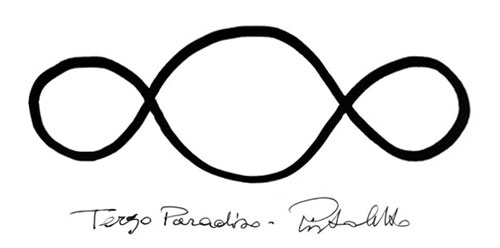
What is the Third Paradise?
It is the fusion between the first and second paradise. The first is the paradise in which humans were fully integrated into nature. The second is the artificial paradise, developed by human intelligence to globalizing proportions through science and technology. This paradise is made of artificial needs, artificial products, artificial comforts, artificial pleasures, and every other form of artifice. Humankind has created a truly artificial world which has triggered, in an exponential manner and in parallel with beneficial effects, irreversible processes of decline and consumption of the natural world. The Third Paradise is the third phase of humanity, realized as a balanced connection between artifice and nature.
The Third Paradise is the passage to a new level of planetary civilization, essential to ensure the survival of the human race. To this purpose we first of all need to re-form the principles and the ethical behaviours guiding our common life.
The Third Paradise is the great myth that leads everyone to take personal responsibility in the global vision.
The term “paradise” comes from the Ancient Persian and means “protected garden”. We are the gardeners who must protect this planet and heal the human society inhabiting it.
The symbol of the Third Paradise, a reconfiguration of the mathematical infinity sign, is made of three consecutive circles. The two external circles represent all the diversities and antinomies, among which nature and artifice. The central one is given by the compenetration of the opposite circles and represents the generative womb of a new humanity.
Michelangelo Pistoletto, 2003
In 2005 Third Paradise was presented at the 51st Venice Biennale in the exhibition “Inner Island: Art of Survival”, curated by Achille Bonito Oliva. The exhibition presented events, meetings and workshops with the participation, among others, of Gilberto Gil in the double role of musician and Brazilian Culture Minister.
From 2007, with the collaboration between Pistoletto and the musician Gianna Nannini, curated by Zerynthia – RAM Radioartemobile, the Third Paradise evolved into a multimedia work in progress. Live events, exhibitions both in Italy and abroad and online activities build up a platform of relations aiming to inspire and produce a social transformation both from a local and a global point of view by spreading the message/myth of the Third Paradise.
In 2010 Michelangelo Pistoletto wrote the essay "the Third Paradise", published by Marsilio Editori.
Buy the book from the online store of Cittadellarte
From Rebirth-day manifesto:
It is time to begin the third stage, in which humanity will reconcile and unite nature and artifice, creating a new balance at every level and in every area of society: the Third Paradise (further information about the project).
Further information about Terzo Paradiso / Rebirth-day: the worldwide day of change
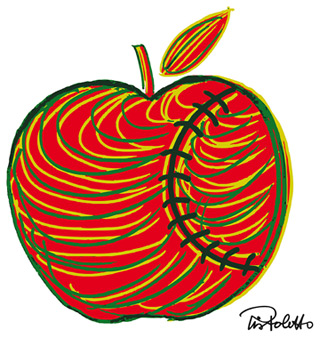

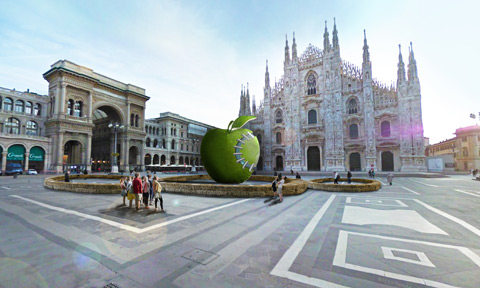
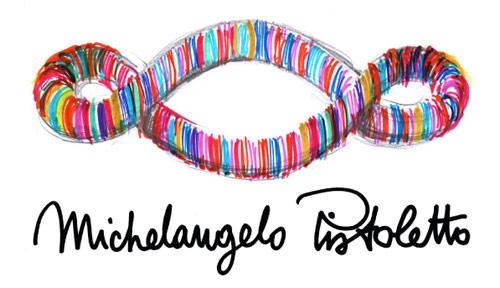
Official video by Gangvideo | Courtesy Camera della Moda di Milano
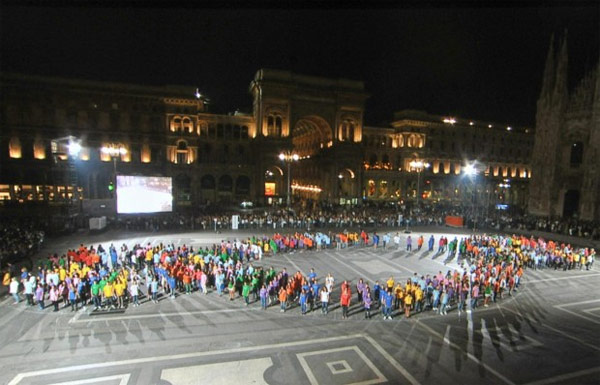

M. Pistoletto (2005), The symbol of Third Paradise traced in San Servolo Island
Partner and sponsor of the project “Inner Island: art of survival” is Fondazione Ermenegildo Zegna with which Cittadellarte has activated since 2000 a significant planning collaboration.
P: Michelangelo Pistoletto
M: A forceful sign that shows the distance you’ve covered, here at the Venice Biennale. But let’s go over the most important steps that brought you to this installation. It might be easy to see Third Paradise as a work unto itself, whereas we know it’s the result of a creative development that began long ago and evolved over time, with the continuous addition of new elements that are part of a single line of reasoning, a comprehensive work.
P: I gradually responded, in a complex way and with different solutions, to a series of basic needs. We could say that a real response to these needs is found in the ’94 Manifesto, Art Project.
M: That declaration, a sort of letter of intent, already held the theoretical framework that would lead to the creation of Cittadellarte.
P: The fundamental points were already laid out in that manifesto.
M: A manifesto that most people at the time called “utopian” but that turned out to be a genuine theoretical basis. A basis on which your later efforts built a global achievement, Cittadellarte.
P: Yes. Another reference point might be the Art Sign, of ’76, as The Third Paradise also is symbolically formulated on a sign — the New Infinity Sign. There is an important difference between the two, however. The Art Sign has individual value, the New Infinity Sign, communal value.
M: So there are already two important components: one is the achievement of Cittadellarte, where what was once a manifesto, a theoretical framework, has become concrete, and what was considered utopian has become reality. Cittadellarte is living evidence of this…
P: It becomes the place…
M: A place of thought, where different things meet and mingle — also, a place of cultural interchange, of activity. Another of the components on which the Third Paradise is based is your reflection on this activity. A further component is the symbolic aspect, which becomes increasingly clear in your work and acquires increasing importance, which emerges, or seems to appear, sua sponte, independently, in this context.
P: I felt the need to use symbolic elements. Before ’76, when I made the Art Sign, symbolic themes didn’t concern me particularly. I was not interested in making signs as symbols, because my work was totally based on specularity, on the mirror. I thought the mirror, in the Mirror Paintings, absorbed and dissolved all symbols, that it was fundamentally antisymbolic.
M: Because of its becoming, because of its capacity to connect different times and spaces, to call everything into question.
P: Because of the mutability of every element that is part of the mirror image. Hence the mirror had drawn every symbol into itself; it had appropriated them all.
M: Also because the mirror could be defined as a metasymbol, something that could embrace all symbols.
P: An archetype by means of which symbols can begin to emerge, the archetype typical of reflection, of the direct signification of existence. Every physical thing exists as an autonomous element, without intellectual reference, whereas the mirror is, in itself, a reference to something that exists. So it is already set up to be a symbol, a symbol of everything real. The necessity to pull the symbols out of the mirror little by little arises when the phenomena I grapple with in life demand to be identified thoroughly and, at the same time, to be…
M: Fathomed, examined in depth…
P: And consequently declared. In this sense symbols become a part of what is necessary to convey what one is doing. To convey the action, the contents of the processes underway. The mirror gives rise to signs that, by degrees, become a language. From the specular totality that has reduced linguistic symbols to zero arise the words that voice new thought.
M: This mirror, which we have called a meta-symbol, and which is a machine for thinking, for reflecting, gradually processes and “spits out” a series of objects and figures that are symbols, to the degree that they are charged with peculiar values.
P: A trace, a mark, corresponds to a thought or an object. New thoughts and new realities call for adequate symbols. This is how a language without precedents is formed.
M: In any case they are symbols to the degree that they are charged with meanings, they bear their own history, a bundle of thoughts and convictions.
P: Symbols can have a history because they have always been around in human society; as diverse as they may be, each carries an archetypal potential.
M: A symbol declares itself, matures, because there is a past history that has made it a symbol; in this connection the mirror has a cathartic function, of creation and concentration.
P: But now we have come to these symbols I’ve marked, drawn…
M: That seem almost to come out of this mirror.
P: It is a mirror that links together memory and becoming. My work with mirrors is always a reflection that goes as far back in the past as it goes forward in the future.
M: So, at a certain point, elements arise in your oeuvre that are strongly characterized, that are declaredly symbols.
P: They are declaredly symbols. The traditional infinity sign acquires a new form and a new value. A third circle appears between the two we’re familiar with. From the union of the two opposed circles arises a third circle that signifies the generation of life. A belly gravid with new life that delineates itself between two generating elements that had thus far been sterile.
M: You take a symbol that already bears its own symbology and history, so to speak, that is already charged with meanings. You act on this symbol by giving it or, or I would say, adding to it new meanings or expanding prior meanings without taking away the past history.
P: I operate on the old symbols. I find their motivation in the past, but I try to graft on the motivations of the present, the current motivations of a vision turned at once to the past and to the future. There are two fundamental signs I experience as a person who lives in this time: one is the infinity sign, the other is the sign of the cross. They are symbolic; they come from history and somehow I must comprehend them in my present, between past and future. They are symbols of the greatest importance that, as a person and an artist, I can’t carry with me without making them objects of my thought and action. Otherwise it would mean bringing a halt to thought as the essential life process.
M: Let’s leave the symbol of the cross, which merits a thorough investigation in its own right, and look more closely at how you configure or transfigure the infinity symbol.
P: The symbol is represented by a line that continues without end. The line cannot consume itself in the process, just as it cannot reach an end point: to do so would contradict the concept of infinity. Both in the old and in the new infinity sign the line never runs out. In the first case it turns around and comes back to cross itself and set off the other way, forming two circles that meet in a point. This image corresponds perfectly to what happens when one cuts a mirror in half. The mirror on the left is reflected in the one on the right, the mirror on the right is reflected in that on the left, and so on ad infinitum.
Division Multiplication of the Mirror, a work I did in 1976, goes beyond the relationship I’ve just described. The two mirrors, unlike the drawn sign, are not compelled to lie on the same plane. They can move on the axis of the cut that has divided them and give rise, as they do in my work, to a reciprocal mirroring that produces a proliferation of reflected mirrors within the pair of mirrors that can grow to infinity. This happens when two reflecting planes are fitted together frontally. The division of the unitary mirror produces the same movement of coming and going made by the line of the infinity sign, but leads beyond the duality proposed by the figure of the old symbol.
M: This is the symbolic path you follow in the creation of your work.
P: The spatial opposition of the two circles expresses the concept of bipolarity, hence of contraries such as positive and negative (as well as male and female). The birth of the Third Paradise results from the procreative encounter of two worlds: that ruled by nature, which we call the Earthly Paradise, and that produced by humankind, which we call Artificial Paradise. The opposition that has developed between the two spheres produces a destructive charge of incalculable proportions, which demands immediate constructive resolution. The artificial system is consuming and polluting the Earth, which contains the substances essential to life, more and more every day.
The necessity of human survival today requires we give a decisive new course to the prospects of progress followed until now.
M: We’ve advanced an interpretation of the Third Paradise by way of symbols.
P: I think of nature as a reality that produces an intelligence of its own thanks to a constant and immanent system in which “chance” plays a crucial role. Humans, in their turn, are driven to create an intelligence that develops progressively. The progression knows no limits and, therefore, can lead to a catastrophe. Now, a catastrophe created by human intelligence does not undermine the natural universe. Damage caused by humans does not weigh on the sensibility of nature, because nature is always ready for anything. It does leave a mark on who caused it — in other words, on humans.
The concept of Third Paradise unites egoism and generosity. People working wisely and responsibly to assure their own survival would end up giving nature a gift of sensitivity, as well as intelligence.
M: One characteristic of this society is, it is marked by an radicalization of consumer attitudes, by the necessity to create needs that are not there, artificial necessities…
P: One no longer seeks just to fulfil the needs that present themselves, one creates other needs that demand fulfilment — drugged needs.
We can say that artifice is the result of human creativity — as the word itself suggests, “to make”, “to make art”. I have no dispute with artifice — all the forms of artifice one can possibly imagine. But we have to realize that that bears consequences, which, as we all know at this point, pose a serious threat to the continuation of human life on the planet.
M: We have seen that the concept of Third Paradise evolves symbolically from The new infinity sign. In your reflection a third womb, a third sphere is created…
P: Back in the Seventies I made a work composed of two spheres: a red one and a reflecting one. A third sphere arose from the reflection of the former in the latter.
M: In effect, we can already find the visual representation of these concepts in some of your works from the Seventies. The concept of procreation appears emblematically and synthetically in the reflecting work Three (1975) and, even more explicitly, in another mirror work, Fertilization (1973-75) in which a boy and a girl hold hands and their seemingly endless intertwined fingers appear to symbolize a new life. But as you said, there is a work that is even more emblematic with respect to your words — one we can take as a genuine visual metaphor of the concepts expressed — The Sphere of the Image (1973-1975). The work establishes a relation between two equal forms that differ in surface and consistency as well as in their potential mobility, as they have different weights: the ball is light, the steel is heavy. Placing them alongside each other, the point of contact generates, by reflection, a third image that is the sum of the other two.
P: One could say that the reflecting sphere is the sphere of human intelligence and the opaque sphere is that of nature.
The problem is that we ruthlessly exploit our intelligence. We abuse our intelligence as we abuse nature. Even good is a sphere and evil is a sphere. I’m interested in what happens when they meet, I want to look into the sphere that is born of the meeting of these two opposites.
M: In this confrontation with the facts you’ve undertaken, we should also underline that the artist can run this course only if one proposes a different function for art. Art is placed at the center of a transformation. The tools that are used to comprehend the world at this point must take account of, or at least reference, a central role for art.
P: A new knowledge of art.
M: Better yet, a new knowledge created by a new function of art.
P: The artist realizes that art can be considered as the source of all that follows in the functions of the human spirit. It is at the origin of the process that brings man to break away from the automatic system of nature and declare his autonomy: from automatic dependency to autonomy.
So all that is produced on the human level has one root: art. At this point in the evolutionary process, art returns conscious of the full weight of its responsibility, no longer unaware of human destiny. Today the artist reflects before a mirrored sphere on all that has been.
M: The Third Paradise, at this point, symbolically speaking, can also be defined in an ontological dimension, in an existential dimension, a dimension of modes of actuation.
P: There is a destructive creativity that is expressed with violence and war. It can be implicitly destructive even when it is productive. Science is a great help when it comes to causing damage. The assumption consists in identifying new capacities of human intelligence, bringing human ingenuity and creativity to make science and every other form of knowledge converge toward the search for balance with nature and responsible relations among people. These two aspects are inseparable, now. The time has come, and cannot be postponed, for the human mind to take a step forward in its evolution, to bring us to live together and live on, on the planet Earth. It’s a matter of coming to grips with history to save the best — of trying, that is, to change whatever it is that damages our existence. Survival is aesthetic, ethical and physical.
M: Does the artist take on a messianic role when he declares this understanding and sets it before all to see?
P: Today, even when one speaks of business, of a company, one uses the word mission, our firm’s mission. Maybe taking on a messianic role means saying there’s a mission. There’s an inclination toward something that somehow must be achieved. The use of words like messianic, so closely tied to the notion of religion, can seem overly ambitious, whereas, in my opinion, there’s actually a risk that the term carry a restrictive meaning. This is because art, precisely because of the creative root it represents in human history, comes before and goes beyond the limits of the religious and the political. It takes on primary features and values both in its vision of the future and in its retrospection.
M: You’re not proposing a confrontation with religions or ideologies?
P: One touches the principles from which politics and religions arise. It is on these fronts that one must take action because they give one room to manoeuvre and offer an operative possibility that, because it is art’s maintains that adogmaticity, that freedom, that capacity…
M: To be a priori with respect to others…
P: Above all taking on a central responsibility. A centrality that the artist acquired in the twentieth century by advancing the individual sign as an absolute, universal reference. This subjective absolute must be considered a principle of the autonomy of the artistic phenomenon itself, hence taken from the individual level to the social.
M: Centrality of the artistic phenomenon as well as priority with respect to other forms of knowledge.
P: Certainly, because art finds itself prodded by responsibility. One returns to where the freedom to create was born, one returns to find the responsibility of art. If the histories of religions…
M: Or even of ideologies…
P: Religions, more than ideologies, can last centuries or millennia, but the history of art is older. At any rate the problem to solve today requires the participation of all, a heartfelt participation that is developing and includes scientists, philosophers, economists, sociologists, even politicians.
M: An ethical development…
P: Which begins by introducing a sense of solidarity with the earth and seeking out new rules of development and competition. But a mental process that permits people to begin to live with new motivations must accompany practical research. We can’t go on associating power with the accumulation of wealth. This approach frees up strong negative components. Components that in the exercise of power, unfortunately (and this is the most perverse side) almost always take on a positive aspect, are presented by those who hold power, as conditions without which there seems to be no salvation. People are steered, with a deliberate goal in mind: that of maintaining a state of credulity, a “faith” that keeps independent thought at a distance. Art cannot follow this system. It cannot give up the creative skill that brings it at this point to endeavor to reshape society.
M: But does all this take the form as a general reflection on a global system and as an outcry, or do you thing a possibility for direct intervention exists?
P: Critique is no longer enough, one must propose and achieve, not just criticize. Cittadellarte, as you know, has many gates — that of economics, for instance. Over this gate is written: “Bank of Human Values”, not of monetary values. Another gate opens on politics with the inscription “Love Difference”. And another opens toward manufacturing, to which I have dedicated the slogan, “Every product assumes social responsibility”. From gate to gate Cittadellarte establishes creative communication with the whole network called “Geographies of Change”, which includes institutions that share our goals.
From the University of Ideas UNIDEE, the first organism born eight years ago inside Cittadellarte, have emerged young people, from all over the world, capable of working actively in the direction of s socially responsible creativity.
From the 19th of November 2007 to 16th December 2007, at NCCA - National Centre for Contemporary Arts in Moscow.
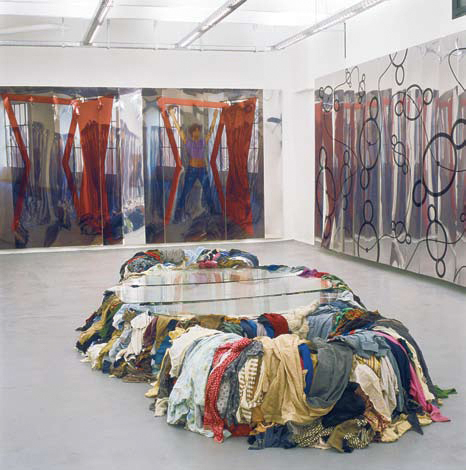
The conceptual center of the exhibition is the New Sign of Infinity by Pistoletto that expands throughout the space on large sheets of aluminum in an infinite repetition.
The installation is completed with the Orchestra di stracci, and the “vocal sculpture” Mama by Gianna Nannini.
The two works entwine, mix and embrace unwinding in syntony and sharing of thought: music becomes a vehicle of communication to translate into myth the concept expressed in the Third Paradise.
The collaboration between Pistoletto and Nannini, curated by RAM Radioartemobile, reshapes itself as an international music network open to musicians from allover the world and becomes Third Paradise / Mama - Free style Music.
From February 8th to April 28th 2007, at bunKerart in Milan.
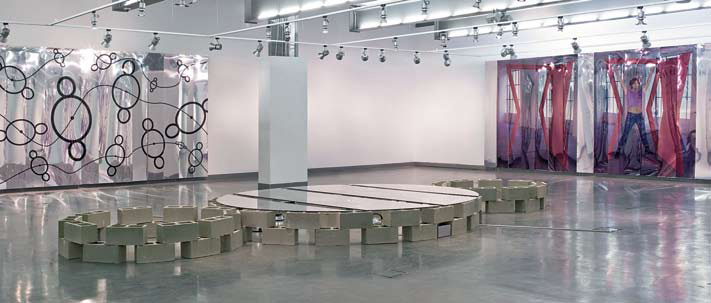
The installation is completed with the Orchestra di stracci, and the “vocal sculpture” Mama by Gianna Nannini. The two works entwine, mix and embrace unwinding in syntony and sharing of thought: music becomes a vehicle of communication to translate into myth the concept expressed in the Third Paradise.
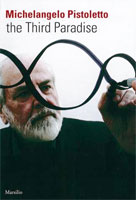
The Third Paradise is the new world.
The symbol of the Third Paradise unites the human community.
The Third Paradise is an evolutionary transition in which human intelligence finds ways to coexist with the intelligence of nature.


